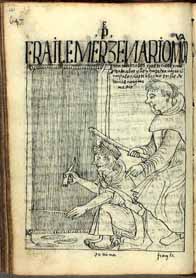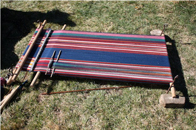Weaving instruments
Vertical loom (telar vertical)
Variety of loom in which the tension of the warp and weft threads is fixed and maintained by the main poles attached to structures that keep the loom perpendicular to the ground, and in some cases, additional weights on the ends of the warp threads. In the Andes this loom variant is generally used to produce tapestry work. The figure above illustrates a vertical loom for tapestry by Guamán Poma de Ayala (ca. 1613).
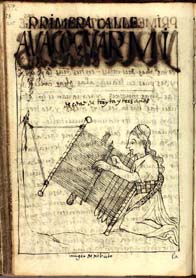
Backstrap loom (telar de cintura)
Traditional variant of Andean loom in which the tension of the threads of warp and weft is maintained by the weaver with her own body. The figure above illustrates a backstrap loom for tapestry by Guamán Poma de Ayala (ca. 1613).
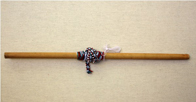
Simple loom (telar de palo)
Type of loom characterised by its simplicity and the use of a single cross pole, that the girls in the Andean region use to learn how to make shawls or braids (in Aymara tirinsa) warp face. The stability of this type of loom is achieved by gripping the pole in the toes.
Horizontal loom (telar horizontal)
Traditional variety of Andean loom in which the tension of the warp and weft threads is fixed and maintained by the set of stakes, ropes and fixed poles of the loom frame which place the loom parallel to the ground. The loom consists of an array of main stakes poles which fasten the warp and another set of mobile poles to alternately raise each of the heddles and introduce the weft into the intermediate space (the opening).
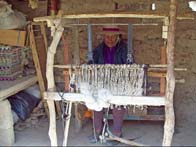
Spanish loom (telar de pedal)
Variant of the loom developed in the East and brought to the Andes at the end of the 16th century by the Spaniards mainly to make baize or rustic cloth. The movement of the heddles is produced by a system of pedals. The tension of weft and warp threads is fixed and maintained by the solid wooden frame of the loom. The figure above shows a rustic Spanish loom currently in use in the community of Alfarcito in Puna, Argentina (courtesy of Lucila Bugallo).
Mechanical loom (telar mecánico)
Mechanical variant of the loom developed originally in Europe and introduced into the Andes in the 19th century to elaborate industrial fabrics. The tension of the warp and weft threads is maintained by the solid metal frame of the loom.
